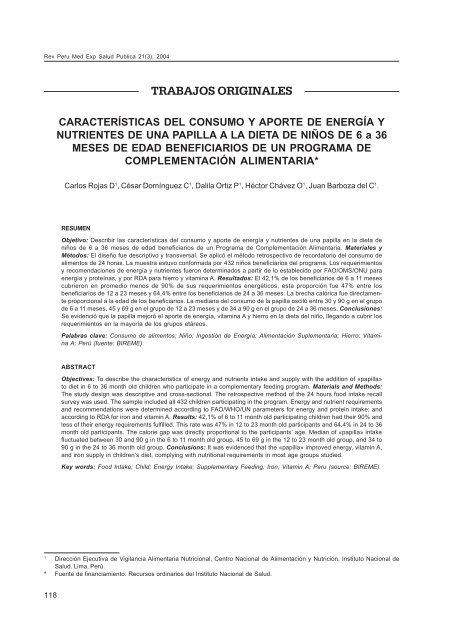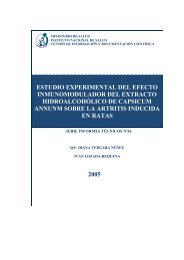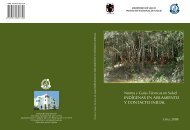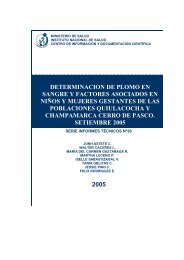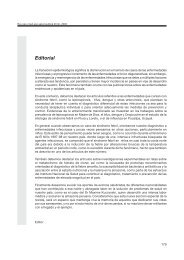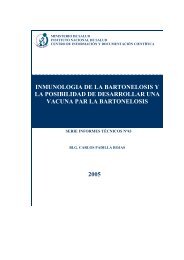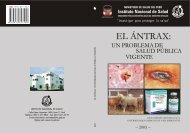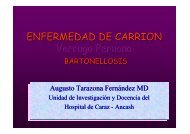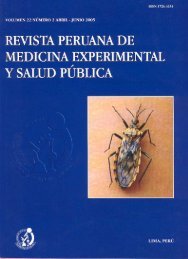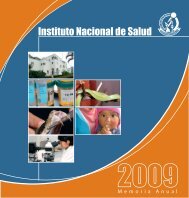Rev Peru Med Exp Salud Publica 21(3), 2004Rojas D. y col.TRABAJOS ORIGINALESCARACTERÍSTICAS DEL CONSUMO Y APORTE DE ENERGÍA YNUTRIENTES DE UNA PAPILLA A LA DIETA DE NIÑOS DE 6 a 36MESES DE EDAD BENEFICIARIOS DE UN PROGRAMA DECOMPLEMENTACIÓN ALIMENTARIA*Carlos Rojas D 1 , César Domínguez C 1 , Dalila Ortiz P 1 , Héctor Chávez O 1 , Juan Barboza del C 1 .RESUMENObjetivo: Describir las características del consumo y aporte de energía y nutrientes de una papilla en la dieta deniños de 6 a 36 meses de edad beneficiarios de un Programa de Complementación Alimentaria. Materiales yMétodos: El diseño fue descriptivo y transversal. Se aplicó el método retrospectivo de recordatorio del consumo dealimentos de 24 horas. La muestra estuvo conformada por 432 niños beneficiarios del programa. Los requerimientosy recomendaciones de energía y nutrientes fueron determinados a partir de lo establecido por FAO/OMS/ONU paraenergía y proteínas, y por RDA para hierro y vitamina A. Resultados: El 42,1% de los beneficiarios de 6 a 11 mesescubrieron en promedio menos de 90% de sus requerimientos energéticos, esta proporción fue 47% entre losbeneficiarios de 12 a 23 meses y 64,4% entre los beneficiarios de 24 a 36 meses. La brecha calórica fue directamenteproporcional a la edad de los beneficiarios. La mediana del consumo de la papilla osciló entre 30 y 90 g en el grupode 6 a 11 meses, 45 y 69 g en el grupo de 12 a 23 meses y de 34 a 90 g en el grupo de 24 a 36 meses. Conclusiones:Se evidenció que la papilla mejoró el aporte de energía, vitamina A y hierro en la dieta del niño, llegando a cubrir losrequerimientos en la mayoría de los grupos etáreos.Palabras clave: Consumo de alimentos; Niño; Ingestión de Energía; Alimentación Suplementaria; Hierro; VitaminaA; Perú (fuente: BIREME).ABSTRACTObjectives: To describe the characteristics of energy and nutrients intake and supply with the addition of «papilla»to diet in 6 to 36 month old children who participate in a complementary feeding program. Materials and Methods:The study design was descriptive and cross-sectional. The retrospective method of the 24 hours food intake recallsurvey was used. The sample included all 432 children participating in the program. Energy and nutrient requirementsand recommendations were determined according to FAO/WHO/UN parameters for energy and protein intake; andaccording to RDA for iron and vitamin A. Results: 42,1% of 6 to 11 month old participating children had their 90% andless of their energy requirements fulfilled. This rate was 47% in 12 to 23 month old participants and 64,4% in 24 to 36month old participants. The calorie gap was directly proportional to the participants’ age. Median of «papilla» intakefluctuated between 30 and 90 g in the 6 to 11 month old group, 45 to 69 g in the 12 to 23 month old group, and 34 to90 g in the 24 to 36 month old group. Conclusions: It was evidenced that the «papilla» improved energy, vitamin A,and iron supply in children’s diet, complying with nutritional requirements in most age groups studied.Key words: Food Intake; Child; Energy Intake; Supplementary Feeding; Iron; Vitamin A; Peru (source: BIREME).1Dirección Ejecutiva de Vigilancia Alimentaria Nutricional, Centro Nacional de Alimentación y Nutrición, <strong>Instituto</strong> Nacional deSalud. Lima, Perú.* Fuente de financiamiento: Recursos ordinarios del <strong>Instituto</strong> Nacional de Salud.118
Rev Peru Med Exp Salud Publica 21(3), 2004Consumo y aporte de nutrientes de una papilla a la dieta en niñosINTRODUCCIÓNLa <strong>salud</strong> de la población depende en gran parte de loshábitos alimentarios y la buena nutrición recibida en laniñez, las cuales cuando son inadecuadas conducena una malnutrición íntimamente relacionada con lapobreza y enfermedades infecciosas; afectando lasposibilidades de estimulación y aprendizaje con consecuenciasnegativas para el desarrollo físico y mental;incluso pudiendo conducir a la muerte debido aque la desnutrición es un factor altamente relacionadocon la mortalidad infantil 1,2 .Para el año 2002, la tasa de mortalidad por cada 1000nacidos vivos en niños menores de 5 años fue de 82 anivel mundial, de 34 en América Latina y el Caribe, y 90en los países en desarrollo 3 . En el Perú para el año2000 la tasa de mortalidad por cada 1000 nacidosvivos en niños menores de 5 años fue de 47 4 . Por otrolado, a nivel mundial y para el año 2002, la desnutricióncrónica afectó a 31% de los niños menores de 5años, en América Latina y el Caribe a 16% y en lospaíses en desarrollo al 32% 3 , en el Perú la cuarta partede la población referida (25,4%) se ve afectada poreste problema 4 .La desnutrición crónica, la anemia por deficiencia dehierro y la deficiencia subclínica de vitamina A formanparte de los principales problemas de <strong>salud</strong> públicaen la población infantil de nuestro país 4 .Por ello, en el Perú se vienen ejecutando diversos programasde intervención orientados a reducir la desnutricióny mejorar las condiciones de <strong>salud</strong> en la poblaciónmás vulnerable. Estos programas tienen comouno de sus principales componentes la entrega dealimentos. Entre ellos están el Programa de Alimentacióny Nutrición para Familias de Alto Riesgo, el Programade Complementación Alimentaria para Gruposen Mayor Riesgo, el Programa Nacional Wawawasi, elPrograma de Comedores Infantiles, entre otros 5 .El Programa de Complementación Alimentaria paraGrupos en Mayor Riesgo se crea en el año 1994, siendosu principal objetivo la prevención de la desnutrición,evitando daños irreversibles e irreparables en elcrecimiento y desarrollo intelectual de los niños de 6 a36 meses de edad, residentes en los departamentosde mayor pobreza del Perú (Ancash, Ayacucho,Apurímac, Cusco, Cajamarca, Huancavelica y Puno);teniendo como principal componente la entrega de unaración de alimento de reconstitución instantánea denominado«papilla». La papilla está formulada paracubrir el 30% de los requerimientos energéticos, 100%de vitamina A, C y hierro y alrededor de 60% de losrequerimientos en otros micronutrientes para los niñosde 6 a 36 meses. Asimismo, dicho programa tieneotros componentes como: educación alimentarianutricional,orientación sobre prácticas de higiene, vigilancianutricional y facilitación del acceso a los serviciosde <strong>salud</strong>.La información presentada en este estudio forma partede la evaluación de impacto del Programa deComplementación Alimentaria para Grupos de MayorRiesgo ejecutada en el primer trimestre del año 2003por el consorcio Maximixe - <strong>Instituto</strong> Cuanto, por encargoy supervisión técnica del Centro Nacional de Alimentacióny Nutrición del <strong>Instituto</strong> Nacional de Salud.El objetivo del presente estudio fue describir las característicasdel consumo y el aporte de energía y nutrientesde la papilla a la dieta habitual de los niños de 6 a 36meses de edad beneficiarios del Programa deComplementación Alimentaria para Grupos en MayorRiesgo.MATERIALES Y MÉTODOSDISEÑO Y MUESTRAEl estudio fue observacional, descriptivo y transversal.Primero se seleccionaron a los establecimientos de<strong>salud</strong> en los departamentos donde se ejecuta el Programade Complementación Alimentaria para Gruposde Mayor Riesgo. Luego se obtuvo aleatoriamente2730 hogares para la aplicación de la encuesta, recabandoinformación relacionada con las característicasdel hogar, conocimientos, actitudes y prácticas sobrealimentación y <strong>salud</strong>, mediciones antropométricas ydeterminación de hemoglobina. Adicionalmente se escogióal azar una submuestra conformada por 432 niñosbeneficiarios para la aplicación adicional de unaencuesta de consumo de alimentos. Se excluyó delestudio a aquellos niños que el día anterior a la encuestano consumieron la papilla, además a quienespresentaban enfermedades severas o crónicas (infeccionesrespiratorias o diarréicas, congénitas, etc.)que podrían alterar su alimentación normal. Para elpresente trabajo sólo se presenta la información relacionadacon el consumo de alimentos, incluida la papillaentregada a través del programa.119


